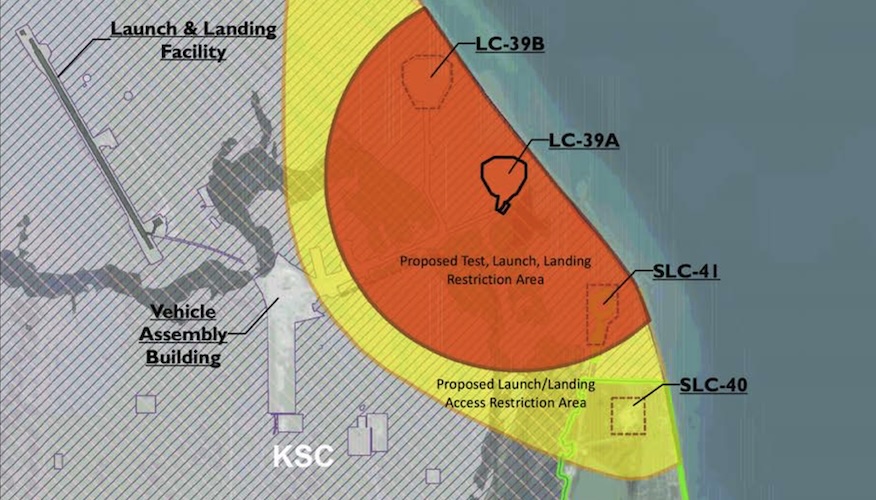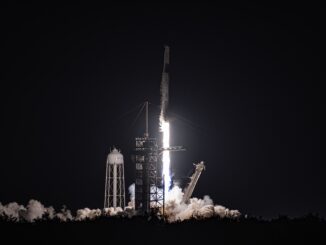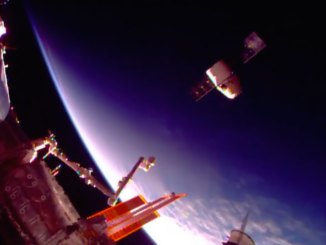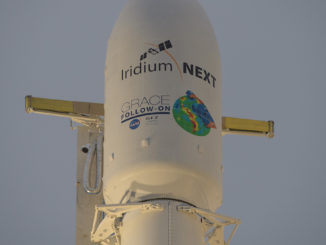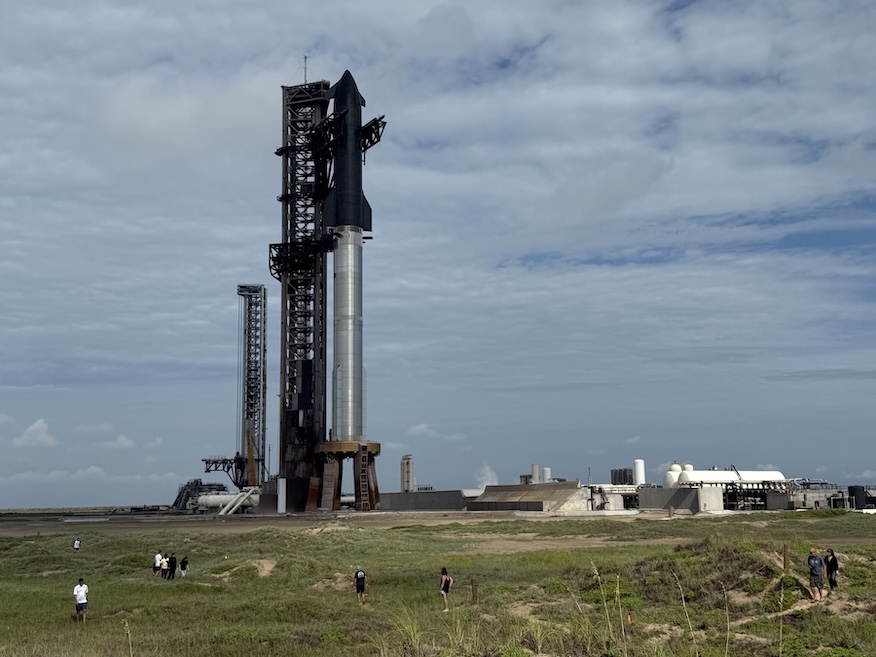
Update Aug. 25, 8:22 p.m. EDT: An anvil cloud forced a mission scrub. The launch is now scheduled for no earlier than Tuesday at 6:30 p.m. CDT (7:30 p.m. EDT / 2330 UTC).
SpaceX was once again unable to launch the 10th test flight of its Starship rocket from southern Texas as soon as Monday evening, but it ran into weather problems.
Anvil clouds over the launch site were the culprit behind the prevented launch. They presented a lightning risk, which wasn’t able to clear in the time available to SpaceX once they started fueling.
The Monday evening scrub followed a scrub on Sunday connected to an issue with its liquid oxygen system at the launch site. A new launch attempt could come as soon as Tuesday, but that hasn’t been determined.
SpaceX completed stacking of its more than 400-foot-tall rocket Saturday night as it aimed for its first launch attempt on Sunday. Less than 20 minutes after SpaceX began fueling the upper stage, Ship 37, there was an apparent issue and SpaceX halted its countdown clock at T-minus 39 minutes and 55 seconds.
Minutes later, at 6:13 p.m. CDT (7:13 p.m. EDT / 2313 UTC) SpaceX announced on social media that it was scrubbing the Sunday launch attempt to “allow time to troubleshoot an issue with ground systems.”
About six hours after that post, SpaceX Founder and Chief Engineer Elon Musk took to his social media site, X, to says that the issue was a “ground side liquid oxygen leak.” Crews were seen working on the quick disconnect around the time of Musk’s post and there were still personnel there as of 11:45 a.m. CDT (12:45 p.m. EDT / 1645 UTC).
The quick disconnect includes a walkway that provides access to the system that allows both liquid oxygen and liquid methane to flow onboard the Ship’s propellant tanks.
During the first launch attempt, SpaceX closed the public road adjacent to Pad A at 11 a.m. CDT (12 p.m. EDT / 1600 UTC) and cleared the pad of its employees about an hour and a half later. A similar timeline is expected for a launch attempt Monday evening.
Flight 10 represents a nearly identical mission plan as Flight 9, which launched at the end of May. SpaceX will not attempt to catch the Super Heavy booster, tail number B16. Instead, SpaceX plans to preform a controlled water landing in the Gulf and demonstrate that it can safely land in an off-nominal scenario.
The plan is to use two of the three center engines for the landing burn along with one of the ten middle ring engines. The idea is to show that if one of the center engines were to fail during a landing attempt, the Super Heavy booster could still be safely caught by the launch tower.
Meanwhile, Ship 37 will attempt to perform a nominal, suborbital flight. That includes deploying simulator Starlink satellites, relighting one of its Raptor engines and performing a controlled splashdown in the Indian Ocean a little more than an hour after liftoff.
Flight 6 was the last time a Ship made it safely to the Indian Ocean, but that was using a Block 1 version of the upper stage. All three previous launches of the 171-foot-tall (52 m) vehicle experienced issues that either prevented it from completing its ascent burn (as seen during Flight 7 and Flight 8) and from deploying the Starlink simulators or performing the Raptor relight in space (seen Flights 7-9).
Before Flight 10 could take place, Ship 36 exploded at SpaceX’s test site called Massey’s and heavily damaged several pieces of critical infrastructure there. That anomaly during fueling for a six-engine static fire test was attributed to the failure of one of the spacecraft’s composite over wrapped pressure vessels (COPVs).
SpaceX’s Starship uses gaseous nitrogen for its environmental control system. The issue was caused by “undetectable or under screened damage” to a COPV.
The launch comes the same week as folks in Central Florida are able to learn more about SpaceX’s plans to launch and land Starship at Launch Complex 39A at NASA’s Kennedy Space Center. SpaceX is proposing up to 44 launches, 88 landings at LC-39A (44 for Starship and 44 for Super Heavy) and up to 88 static fires (lasting up to 15 seconds) annually.
The Federal Aviation Administration (FAA) is hosting four public, in-person meetings this week along with a virtual meeting scheduled for Sept. 3 to discuss the published draft environmental impact statement (EIS) connected to the proposal. Public comment is also open through Sept. 22.
- Tuesday, August 26, 2025; two meetings: 1:00 PM–3:00 PM & 6:00 PM–8:00 PM ET at the Astronauts Memorial Foundation, Center for Space Education, Conference Center, State Road 405, Kennedy Space Center, FL 32899
- Thursday, August 28, 2025; two meetings: 1:00 PM–3:00 PM & 6:00 PM–8:00 PM ET at the Radisson Conference Center, Grande Caribbean, 8701 Astronaut Boulevard, Cape Canaveral, FL 32920
- Virtually on Wednesday, September 3, 2025; 6:00 PM–8:00 PM ET
- Registration Link: https://us02web.zoom.us/webinar/register/WN_2aotlSQERXCHC5yJjOvm5
- A Dial-in phone number: 888-788-0099 (Toll Free)
- Webinar ID: 892 9206 9685
- Passcode: 095859
